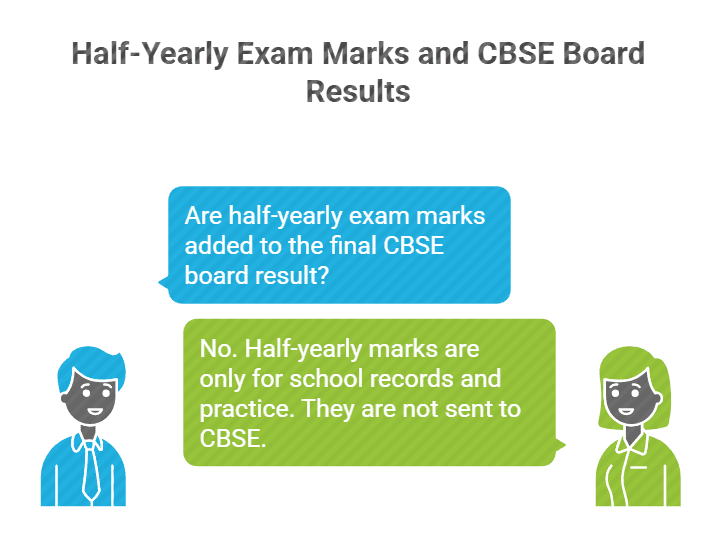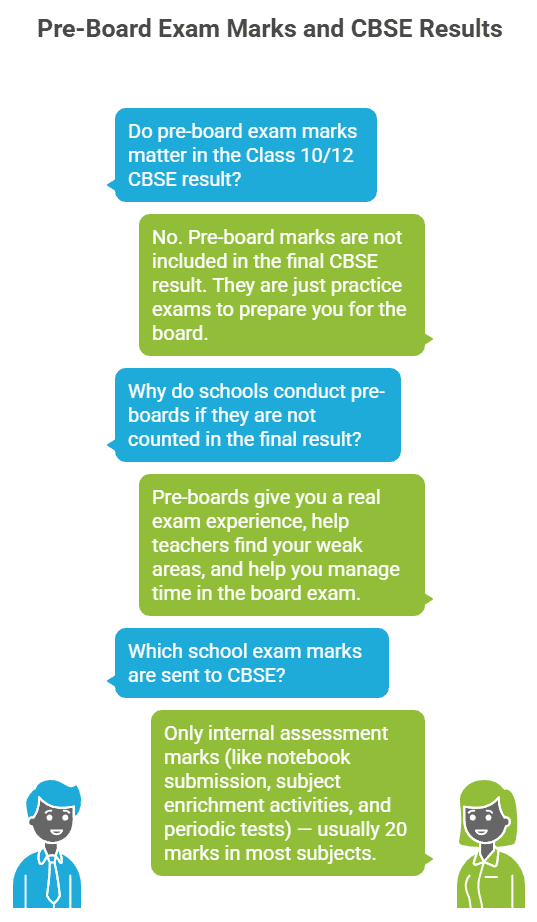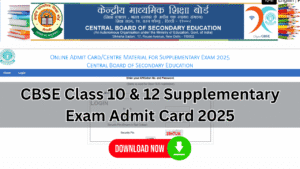Half-Yearly Exams vs Pre-Boards: Let’s be honest – exams can feel like a never-ending rollercoaster. Just when you survive your periodic tests, Half-yearlies arrive. And right when you think you can breathe again, you hear about pre-boards. Suddenly, your brain’s like, “Wait… how are they different? Which one should I be more worried about? And Are half-yearly exam marks/pre-boards marks added to the final CBSE board result? ”
If that’s you right now, you’re not alone. Every year, thousands of students sit in the same confusion, not knowing how these two exams actually affect their final results or preparation strategy. But don’t worry, by the end of this blog, you’ll know exactly what each exam means, why they exist, and how you should approach them.
Table of Contents
Understanding Half-Yearly Exams
Think of half-yearlies as the mid-season check-up of your academic year. They usually happen in the middle of the session (around September–October) and cover the syllabus from the first half of the year.
Purpose of Half-Yearlies:
- Assess early learning – Teachers want to know how well you’ve understood concepts taught so far.
- Identify weak areas – Since there’s still time left in the year, you can work on your mistakes without the pressure of final boards hanging over you.
- Get into the exam mindset – They’re your warm-up match for the bigger games ahead.
Key things to remember:
- The syllabus is limited to what’s taught in the first term
- Marks often contribute to internal assessments (depending on your school).
- The pressure is lower compared to boards or pre-boards, but that doesn’t mean you should ignore them.

Understanding Pre-Board Exams
Pre-boards are the final rehearsal before the real show, the board exams. They usually take place 2–3 months before your board exams (around December–January for most schools) and cover the entire syllabus.
Purpose of Pre-Boards:
- Simulate board exam conditions – Same pattern, similar difficulty level, and full syllabus coverage.
- Test your readiness – This is your reality check. You’ll know exactly where you stand for the actual boards.
- Build exam stamina – Boards are long and mentally demanding, so pre-boards train you to handle that pressure.
Key things to remember:
- Syllabus = covers 100% of your board exam topics, which means the entire syllabus.
- Schools often make them slightly tougher than actual boards to prepare you for the worst.
- Your pre-board marks give you and your teachers a clear idea of how ready you are for the boards, helping everyone plan the final phase of preparation accordingly.

Major Differences: Half-Yearly Exams Vs Pre-Boards
| Aspect | Half-Yearly Exams | Pre-Board Exams |
| Timing (common schedule) | Mid-academic year (Sep–Oct) | A few months before boards (Dec–Jan) |
| Syllabus | Only first-half topics | Entire syllabus |
| Purpose | Identify early weaknesses & check progress | Final practice for boards & gauge readiness |
| Pressure Level | Moderate | High |
| Difficulty | Moderate, sometimes easier than finals | Equal to or tougher than boards |
| Impact on Final Result | Contributes to internal assessment in some schools | No direct marks in boards, but crucial for practice |
| Exam Mindset | Warm-up stage | Final exam rehearsal |
Which One Matters More: Half-Yearly or Pre-Board Exams
You might be asking: So, which one matters more, half-yearly or pre-board exams? Here’s the truth: They both matter, but in different ways.
- Half-Yearlies are important because they build your base. If you mess up here, you might struggle to catch up in the second half of the year. They also give you a less pressured chance to experiment with your study methods.
- Pre-Boards, however, have a higher weight in practical terms. They show you exactly how ready you are for boards, and poor performance here is a sign you need immediate and serious action.
You can simply think of it like sports:
- Half-yearly = practice match where you can try different strategies.
- Pre-board = final friendly match before the championship.
How to Approach Both Half-Yearly & Pre-Board Exams?
Here are some practical tips on how to approach both half-yearly and pre-board exams:
For Half-Yearlies
- Focus on understanding concepts instead of rote learning.
- Use them to identify your weak chapters early.
- Make short notes now; they’ll save you in pre-board and board prep.
For Pre-Boards
- Practice solving full-length papers under timed conditions.
- Revise the entire syllabus, not just your favorite topics.
- Work on presentation skills like neat handwriting, stepwise answers, and clear diagrams.
Mistakes Students Often Make (And How to Avoid Them)
1. Ignoring half-yearlies, thinking they’re “just internal exams.”
Mistake: Many students treat half-yearlies as if they don’t matter. But skipping serious preparation here leads to a weak foundation, and that weakness shows up big time when pre-boards arrive.
How to avoid it: Treat half-yearlies as a chance to build your base. Even if the marks don’t seem huge now, the learning you gain will save you months of stress later.
2. Treating pre-boards like the actual boards in terms of panic.
Mistake: Some students go into full panic mode for pre-boards, forgetting that they’re practicing. Yes, they’re important, but they’re designed to help you make mistakes and improve before the real deal.
How to avoid it: Take them seriously, but with a calm mindset. Focus on finding your weak spots, not just chasing perfect scores.
3. Not analysing mistakes.
Mistake: Finishing an exam, getting your marks, and moving on without checking what went wrong is a wasted opportunity.
How to avoid it: After every test, go through your paper. Ask yourself, was it a concept issue, a silly error, or time mismanagement? Then fix it before the next exam.
Half-Yearlies and Pre-Boards in a Nutshell
If you’re a student wondering whether half-yearlies or pre-boards matter more, here’s your takeaway:
- Half-yearlies are your opportunity to build a strong foundation and get into exam mode without intense pressure.
- Pre-boards are your last chance to test yourself before boards and make improvements.
Final Words
Treat half-yearlies as the learning phase and pre-boards as the testing phase. If you approach both with the right mindset, your final board exams will feel less like a scary mountain and more like a familiar path you’ve walked before.
So, instead of worrying about which matters more, focus on using each for its real purpose. Because if you prepare well for both, the boards will just be another exam, not a nightmare. That way, you will walk into the exam hall with full confidence, not feeling stressed or overwhelmed. Wishing you all the best, have faith in your hard work, and you’ll shine in every exam.








